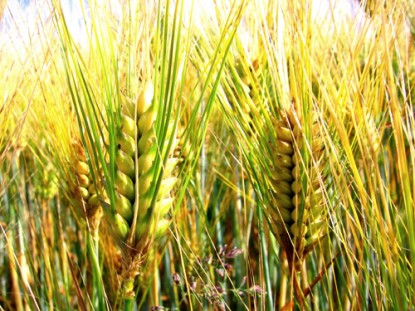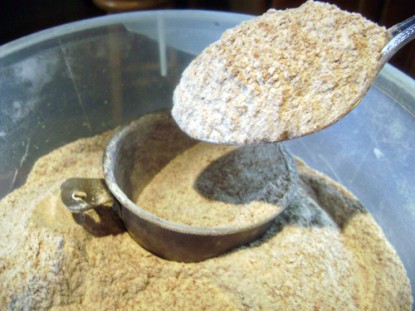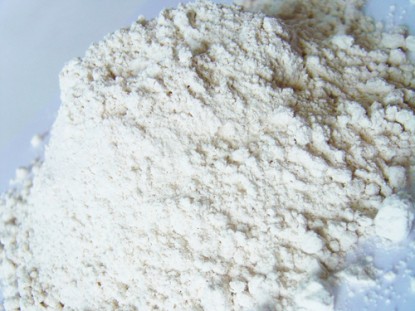
Whether you’re making breads, cakes, cookies, pastries or pastas, one of the main ingredients is flour. There are so many different types flours and each is suited to different recipes. To get the best of your baking, it is important to know what the right flour is for the job (and therefore knowing how to substitute it with what you have)!

Whole-wheat flour is made from the whole kernel of wheat and is higher in dietary fiber and overall nutrient content than white flours. It does not have as high a gluten level, so often it’s mixed with all-purpose, bread flour or dough enhancer when making yeast breads.
A substitute for wheat flour: 7/8 cup all purpose flour plus 2 tablespoons wheat germ.

White flour is refined (stripped of the bran and germ) so it is lighter than whole wheat flour and has less fiber, fat, vitamins, and minerals. Enriched white flour has had B vitamins and iron added back in. Bleached white flour has less protein than unbleached white flour and is slightly acidic.
- All-purpose flour is the most common of the white flours. It is a blend of hard and soft wheat and can be either bleached or unbleached. It has between 8%-11% gluten content (bleached being the lower).
- Cake flour is fine-textured and made with bleached soft-wheat flour, giving it a high starch content. It has the lowest protein content of any wheat flour with a 8%-10% gluten content. Because it’s bleached, a cake sets faster and distributes fat more evenly through the batter to improve texture. When you’re making baked goods with a high ratio of sugar to flour, this flour will hold its rise better and will be less liable to collapse. Cake flour is an excellent choice if you want fine-textured cakes, quick breads, muffins or cookies.
A substitute for cake flour: For every 1 cup of all-purpose flour, add 2 tablespoons cornstarch.
- Bread flour is white flour made from hard, high-protein wheat. It has more gluten strength and protein content than all-purpose flour. It is unbleached and sometimes conditioned with ascorbic acid, which increases volume and creates better texture. Bread flour has 12% to 14% gluten. This is the best choice for anything you’re making with yeast.
A substitute for bread flour: For every 1 cup of unbleached all-purpose flour, add 1 tablespoon vital wheat gluten. For an even higher gluten content, add 2 tablespoons per cup.
- Self-rising flour is a low-protein flour with salt and baking powder already added. Biscuit and quick bread recipes may call for self-rising flour (while not calling for salt or baking powder).
A substitute for self-rising flour: 1 cup all-purpose flour plus 1 teaspoon baking powder, 1/2 teaspoon salt, and 1/4 teaspoon baking soda.
- Pastry flour is made with soft wheat. It’s a mix between all-purpose flour and cake flour. It has 9%-10% gluten. Recipes for biscuits, pie crusts, brownies, cookies or quick breads may call for pastry flour. Pastry flour makes a tender but crumbly pastry.
A substitute for pastry flour: Use 2 parts of all-purpose flour to 1 part of cake flour.
Semolina flour is made from durum wheat, the hardest type of wheat grown. This flour is highest in gluten, therefore highest in protein. It’s used in pastas and breads and can be used to thicken soups or stews. It can also be simmered briefly with raisins and honey for a hot cereal or can be cooked and prepared like Polenta.
A substitute for semolina flour: (in pastas and breads) use equal amounts of all-purpose flour, though the end product will be softer.
Rice flour is made from finely milled rice–either white or brown rice. In recent years, more rice flour is being used in cereals, crackers, chips, snacks, and coating or batter recipes for different texture.
A substitute for rice flour: Equal amounts of cake or pastry flour or grind rice with a spice grinder.
Oat flour is ground oats and is gluten free. This flour can be used in a wide variety of recipes, but baked goods will not rise or hold together. Oat flour must be mixed with other flours in baking, whether in a gluten free recipe or wanting to add to a regular recipe.
A substitute for oat flour: Use a spice grinder to grind oats of your choice.
Buckwheat flour is ground buckwheat. It has a rich, nutty flavor, is high in nutrition, and is gluten free.
A substitute for buckwheat flour: If gluten isn’t an issue, use 1:1 wheat flour mixed with ground flax (for flavor). If gluten is an issue, other flours such as oat or rice flours can be substituted 1:1.
I personally use all-purpose or whole-wheat flour for my baking, semolina flour for my pastas, and grind my own rice and oats for rice and oat flour. If a recipe calls for one of the other types of flours, I don’t hesitate to substitute or adapt. Knowing how each of the flours works in a recipe helps adapting the recipe for your own use.
All of the white flour substitutions have been added to Emergency Substitutions.
Cindy blogs at Chippewa Creek ~ Our Life Simplified. Do you have a recipe post or kitchen-related story to share on the Farm Bell blog? See Farm Bell Blog Submissions for information and to submit a post.
Want to subscribe to the Farm Bell blog? Go here.



GrannyTrace says:
Thanks Cindy for all the flour info. I needed cake flour one day and didnt have any..Now I can make my own.
Granny Trace
http://www.grannytracescrapsandsquares.com
On June 2, 2011 at 4:40 am
Robin from Rurification says:
What do you use to grind your rice and oats into flour?
On June 2, 2011 at 7:04 am
CindyP says:
@Rurification … I just use my spice/coffee grinder (it’s easiest to wipe out and clean up!) to make small batches as I need it. It seems to grind it up the best for me. With the rice, I use short spurts just like grinding coffee, not constant, until it’s small pieces then I whir it until it’s a powder.
On June 2, 2011 at 7:19 am
Mary says:
Good info on flour. I make all of my breads, pasta, pizza, etc. Semolina is necessary for good pasta, I think. Semolina is very expensive when compared to other flours however. I was delighted to discover chapati flour at Costco for 50 cents/pound (compared to $2.60 for semolina). It is 100 percent Durham wheat and is great for pasta and dusting the pizza stone. You can also make chapatis!
On June 2, 2011 at 7:23 am
CindyP says:
I’ve never come across chapati flour (and didn’t see it in any of my research pages until I specifically googled “chapati flour”). I believe semolina is only the starchy part of the durum wheat (separated from the bran and wheatgerm). Chapati (atta) is the entire durum wheat.
Will have to check it out! Thanks!
On June 2, 2011 at 7:45 am
Brenda H. says:
I am so glad you posted this, I was just thinking about pastry flour last night. Do you know if there is a way to make my own whole wheat pastry flour, I have 150 lbs of wheat and need new ways to use it. Any help would be appreciated. Thanks!
On June 2, 2011 at 9:47 am
carriej says:
That is the best article EVER!! I have run into so many recipes that call for cake flour, NONE of the stores have it and I couldn’t find out how to substitute. Thank you!
On June 2, 2011 at 10:48 am
Miss Nellie says:
Great info on flour Cindy. Thank you for the info in the comments on durum and semolina. I love to make my own pasta but don’t have access to semolina. Maybe I will look online to order some.
On June 2, 2011 at 11:04 am
CindyP says:
@brenda What type of whole wheat do you have? WW pastry flour is a soft wheat, low protein (gluten). WW flour has low gluten, but is dense. Only guessing here, but I wonder if you add the cornstarch like the all-purpose cake flour, if it would give you the same affect?
On June 2, 2011 at 9:55 pm
Brenda H. says:
Thanks Cindy, I have hard white wheat so I don’t know that it would work. I can always try it since I have a lot of wheat. Thanks for the response.
On June 3, 2011 at 10:06 am
Darlene in North GA says:
You HAVE to have soft white spring wheat to get pastry flour. There’s not much you can do to hard red or white wheat to lower the protein content. It’s the protein content that makes the gluten that makes pastries tough.
Here in the south we have Mrs. White and White Lily flour for making biscuits. If you look on the side of the bag at the protein content you’ll see why it makes such good “light” biscuits. It’s low protein. However, if you try and make bread out of it, it’s not so good – unless you add a lot of vital gluten to it because there’s not a lot of protein in it to make gluten. Gluten is what holds the air bubbles and causes the bread to both rise and be more pliable instead of crumbly. (I have a recipe on my blog for a “foldable” whole wheat bread that I make in my ABM).
I don’t know if you can get away with sifting out the bran. It depends on how finely your wheat grinder grinds your wheat. But then, courser flour isn’t going to make a good pastry either. About the only thing that will work is making it half ww and half AP flour.
Also, you can use wheat for cracked wheat or whole wheat cereal, mix it into soups, stews and chilis and make “wheat meat” (gluten meat) out of it. You can also use the left-over bran from making wheat meat for bran flakes and dry the wheat meat, grind it fine and use it for….VITAL GLUTEN – so you don’t have to go BUY it.
(this is probably more than you EVERY wanted to know! sorry)
On June 10, 2011 at 9:08 pm
stuckinmiami says:
I have a question about Tortilla Flour. Is there a difference between that and AP Flour? Is it the same?
On January 25, 2012 at 1:13 pm
CindyP says:
I only use AP flour to make my flour tortillas 🙂
On January 25, 2012 at 1:19 pm
bobh1933 says:
Torilla flour is different in that it contains some corn. AP flour is PLAIN! I recommend Selecta Flour for Tortillas which is what I use. Its instant and easy to use. I would add a couple of tablespoons of LARD to the dough. Yes, LARD! It adds a lot of flavor.
On January 25, 2012 at 5:30 pm
stuckinmiami says:
Thank you bobh1933. I will see if I can find any tortilla flour down here. Being stuck down here in Miami, I can’t find a whole lot of variety. Whenever I mention tortillas here, they send me to the egg aisle. To Cubans a tortilla is similar to an open face omelet, not a flat bread.
On January 26, 2012 at 9:54 am
bobh1933 says:
Hi “Stuck”:
Surely any big market in the Miami area should carry totilla flour (or MasaHarina). I’d be surprised if they didn’t! Mexican cuisine is my favorite ethic food!!! I’ve made tortillas before (by hand) sitting around a campfire in Baja. They were cooked on a sheet of iron across the fire – YUM!!
On January 26, 2012 at 2:18 pm
CindyP says:
MasaHarina is what I use to make corn tortillas…so yes, I guess I’ve heard of tortilla flour 🙂
On January 27, 2012 at 8:37 am
stuckinmiami says:
Masa Harina is corn flour. Like corn meal just ground finer. Back in Oregon we could buy these huge fabric bags of Tortilla Flour at Winco but I never thought to look and see if there was a difference. But now that I am on the other side of the country it is hard to find. My husband was in Oregon over the weekend and I was going to have him pick up a bag of Tortilla Flour but I can’t stand uni-taskers in my kitchen and my husband knows this so he will grill me as to why Tortilla Flour vs. AP. So what else can I use Tortilla Flour for. Now, MasaHarina I can make all kinds of stuff with but I dislike corn tortillas profusely.
On January 27, 2012 at 10:54 pm